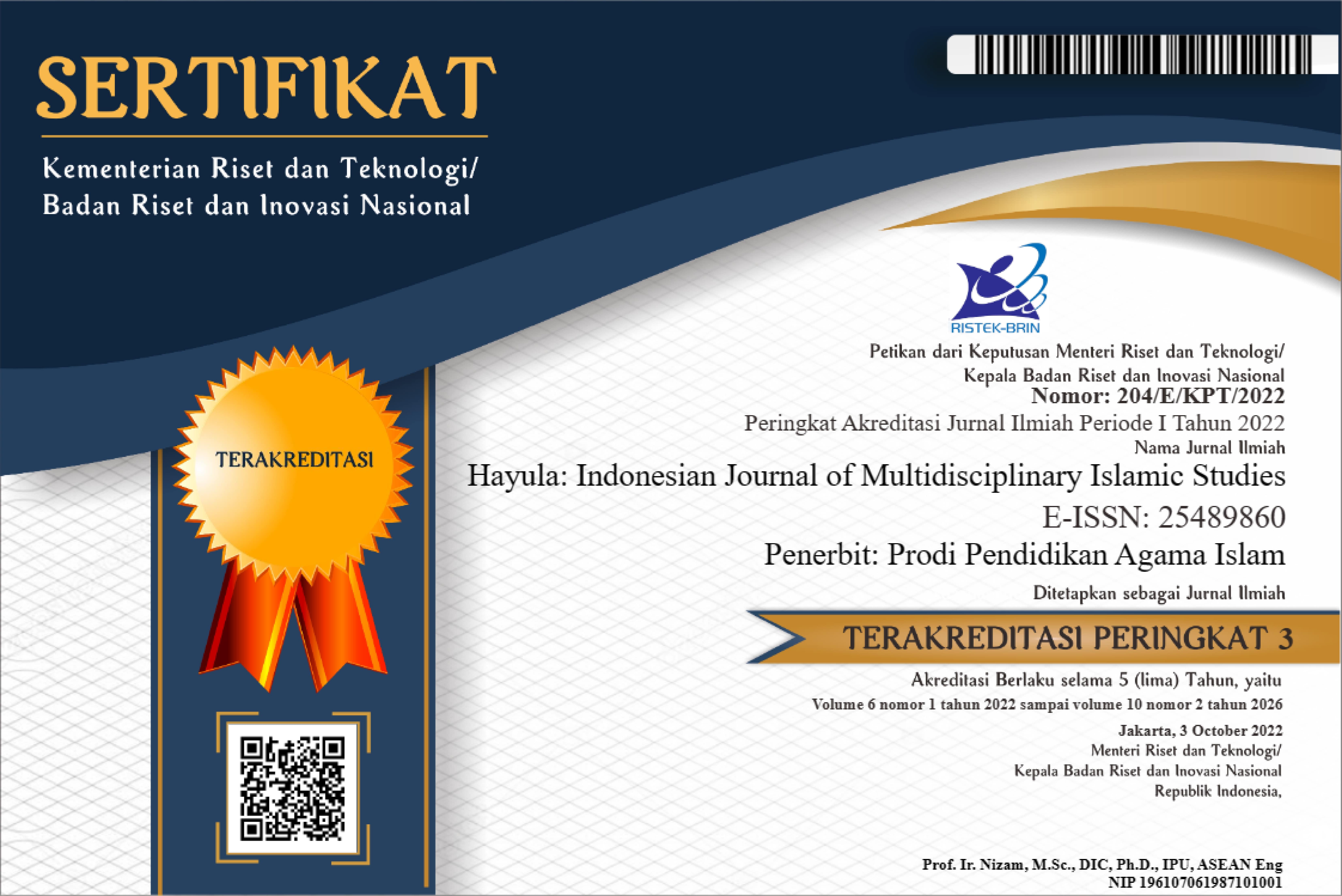Islam and State: A Study on Al-Mawardi and An-Nabhani’s thought and its Compatibility in Indonesian Context
DOI:
https://doi.org/10.21009/005.02.06Keywords:
Islamic political thougt, Al- Mawardi, An-Nabhani, Islam, state relathionship, IndonesiaAbstract
Even though study concerning Islam and politics has been conducted by many researchers, few of them investigating about compatibility of Islamic political thoughts, which originated from the classical and medieval periods that have been influencing Islamic political movements and thoughts in Indonesia, with Indonesian context. Thoughts of Imam al-Mawardi (lived in the 12th Century) and Taqiyuddin al-Nabhani (lived in the 20th Century) are some of them that should be mentioned in this regard. Islamic political thoughts of al-Mawardi become the main reference for Sunni Muslims who are majority in Indonesia, while Islamic political thought of al-Nabhani become the main guidance of HTI (Hizbut Tahrir Indonesia) movement of which its members and followers are many in Indonesia. This article investigates about the political thoughts of al-Mawardi and al-Nabhani concerning the relationship between Islam and state as well as their compatibility with Indonesian context. This study uses the library research in which its primary resources are books written by al-Mawardi entitled Al-Ahkam al-Sulthaniyah and al-Nabhani entitled Ad-Daulah al-Islamiyah. By utilizing qualitative content analysis, data were collected and analyzed. This article argues that the Islamic political thought of al-Mawardi has been adopted by majority of Indonesian Sunni Muslims with some adjustments with Indonesian context, so that his thoughts become compatible with the concept of modern nation-state of Indonesia. On the other side, Islamic political thought of al-Nabhani which developed within a spirit of resistance to Western (European) colonialism has been adopted and campaigned by HTI without adjustment with Indonesian context. This causes al-Nabhani’s thought clashes with the concept of modern nation-state of Indonesia.
References
Al-Mawardi. (2006). Al-Ahkam Al-Sultaniyya. Cairo: Dar al-Hadits.
Al-Nabhani, Taqiyudin. (2002). Al-Dawlah Al-Islamiyyah. Beirut: Dar Al-Ummah.
Asari, Hasan. (2019). “Ulama Training and Modernizing Al-Washliyah Madrasah”, Journal of Contemporary Islam and Muslim Societies, 3(2), pp. 149-175.
Assyaukanie, Luthfi. (2009). Islam and the Secular State in Indonesia. Singapore: ISEAS.
Ayoob, Mohammed. (2008). The Many Faces of Political Islam: Religion and Politics in the Muslim World. The United State of America: The Michigan University Press.
Azra, Azyumardi. (2012). “Revitalisasi Islam Politik dan Islam Kultural di Indonesia.” Indo-Islamika, 1(2), pp. 233-244.
Baswedan, Anies Rasyid. (2004). “Political Islam in Indonesia: Present and Future Trajectory.” Asian Survey, 44(5), pp. 669-690.
Basya, Muhammad Hilali. (2016). Islam, Secularity and the State in Post-New Order Indonesia: Tensions between Neo-Modernist and Revivalist Leaderships in the Muhammadiyah, 1998-2005. Unpublished doctoral thesis, Leeds: University of Leeds-UK.
Basya, Muhammad Hilali. (2011). Muhammadiyah Scholars and Democratic Transition: Response on Radical Islam Movements in Post-New Order Indonesia. Germany: VDM.
Bellah, Robert N. (1976). “Islamic Traditions and Problems of Modernization”, in Robert N. Bellah (ed), Beyond Belief. New York: Harper & Row.
Black, Antoni. (2011). The History of Islamic Political Thought: From the Prophet to the Present. 2nd edition, Edinburgh: Edinburgh University Press.
Bryman, Alan. (2009). Social Research Methods. Third edition. Oxford: Oxford University Press.
Crone, Patricia., Hinds, Martin. (2003). God’s Caliph: Religious Authority in the First Centuries of Islam. London: Cambridge University Press.
Djalal, Abdul. (2020). “Islam Moderat dan Islam Radikal dalam Perspektif Generasi Milenial Kota Surabaya.” Hayula, 4(2), pp. 203-228.
Effendy, Bahtiar. (2009). Islam and the State in Indonesia. Singapore: Institute of Southeast Asian Studies (ISEAS).
Fatoni, Muhammad Sulton. (2017). “Tiga Kekhilafan HTI atas an-Nabhani.” Nuonline, diakses pada 15 Juli 2020 di https://www.nu.or.id/post/read/78210/tiga-kekhilafan-hti-atas-an-nabhani.
Haddad, Wadi Zatoan. (1996). “Ahl al-dhimma in an Islamic State: the teaching of Abu al-Hasan al-Mawardi’s Al-Ahkām al-Sultaniyya”, journal of Islam and Christian–Muslim Relations, 7(2), pp. 169-180.
Hamid, Shadi. (2011). “The rise of the Islamists.” Foreign Affairs, 90(3).
Karim, A., Purnomo, H., Fikriyah, F., & Kardiyati, E. N. (2020). A charismatic relationship: How a Kyai’s charismatic leadership and society’s compliance are constructed? Journal of Indonesian Economy and Business, 35(2), pp. 129–143. https://doi.org/https://doi.org/10.22146/jieb.54705.
Lewis, Bernard. (1988). The Political Language of Islam. Chicago: The University of Chicago Press.
Lewis, Bernard. (2002). What Went Wrong? New York: Oxford University Press.
Machmudi, Yon. (2013). Islamizing Indonesia: the Rise of Jamaah Tarbiyah and the Prosperous Justice Party. Canberra: The Australian National University.
Maksum, Ali. (2017). “Discourses on Islam and Democracy in Indonesia: A Study on the Intellectual Debate between Liberal Islam Network (JIL) and Hizbut Tahrir Indonesia (HTI).” Journal of Indonesian Islam, 11(2), pp. 405-422.
Martin, Richard., Woodward, Mark., Atmaja, Dwi S. (2003). Defenders of Reason in Islam: Mu’tazilism from Medieval School to Modern Symbol. Oxford: One World Publication.
Nasution, Ismail Fahmi Arrauf., Miswari., Sabaruddin. (2019). “Preserving Identity through Modernity: Dayah al-Aziziyah and Its Negotiations with Modernity in Aceh.” Hayula, 3(2), pp. 211-232.
Rahimah, Rt Bai. (2019) “Persepsi Santri tentang Moderasi Islam dan Wawasan Kebangsaan.” Hayula, 3(2), pp. 139-156.
Sabri, Muhammad., Ikhsan, Muh., Wekke, Ismail Suardi. (2018). “Religious and fundamentalism sympthom: Case study of Hizbut-Tahrir Indonesia.” Journal of Engineering and Applied Sciences, 13(6), pp. 5373-5378.
Zulkarnain, Fisher. (2020). “The Political Thought and Movement of Hizbut Tahrir of Indonesia (HTI),” in Journal of Critical Reviews, 7(1), pp. 478-482.
Downloads
Published
How to Cite
Issue
Section
License
Authors who publish with this Journal agree to the following terms:
- Author retain copyright and grant the journal right of first publication with the work simultaneously licensed under a creative commons attribution licensethat allow others to share the work within an acknowledgement of the work’s authorship and initial publication of this journal.
- Authors are able to enter into separate, additional contractual arrangementfor the non-exclusive distribution of the journal’s published version of the work (e.g. acknowledgement of its initial publication in this journal).
- Authors are permitted and encouraged to post their work online(e.g. in institutional repositories or on their websites) prior to and during the submission process, as it can lead to productive exchanges, as well as earlier and greater citation of published works.
Users/public use of this website will be licensed to CC BY







